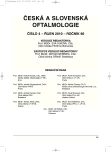General Health State of Premature Children Treated for Retinopathy of Prematurity from 2007 to 2009
Authors:
D. Liláková 1; D. Hejcmanová 1; K. Krylová 2
Authors‘ workplace:
Oční klinika, Fakultní nemocnice v Hradci Králové, přednosta prof. MUDr. Pavel Rozsíval, CSc.
1; Dětská klinika, Fakultní nemocnice v Hradci Králové, přednosta prof. MUDr. Milan Bayer, CSc.
2
Published in:
Čes. a slov. Oftal., 66, 2010, No. 4, p. 176-178
Category:
Original Article
Overview
The aim of this study is to characterize in detail the general health state in infants with retina treated due to retinopathy of prematurity and so to specify the group of premature infants at the highest risk, in which the closest ophthalmologist’s attention needs to be paid in the screening for retinopathy in prematurely born babies. The study group consists of seven patients treated in the Perinatological Center of the Children Clinic of the Faculty Hospital in Hradec Králové, Czech Republic, E.U. during the period 2007 – 2009, in whom the retina was treated for retinopathy of prematurity. In all infants, who had to undergo the retinal treatment, the birth weight was less than 1000 g and a combination of bronchopulmonary dysplasia and infectious disease was present. In infants with the birth weight less than 1000 g, this combination was present in the range from 13.33 % to 23.68 %, which specifies the patients at the most risk. Unfavorable condition after the treatment was caused especially by serious infections and pulmonary complications presented before and after the treatment. Albeit we perform the screening of premature infants according to the current rules, the development shows that the highest attention should be paid to the infants with the birth weight less than 1000 g with complicating diseases as bronchopulmonary dysplasia and infections. For the ophthalmologist, these may be another clue to the presupposition of retinopathy of prematurity prognosis and seriousness besides the birth weight and gestational age. The complicating diseases facilitate to determine accurately the group of premature infants, which is at higher risk of higher grade of retinopathy.
Key words:
Premature infants, retinopathy of prematurity, sepsis, bronchopulmonary dysplasia
Sources
1. Jandeck, C., Kellner, U., Foerster, M., H.: Die Frühgeborenenretinopathie. Klin Monatsbl Augenheilkd, 221, 2004: 147–159.
2. Jandeck, C., Kellner, U., Lorenz, B., Seiberth, V.: Leitlinie zur augenärztlichen Screening-Untersuchung von Frühgeborenen. Klin Monatsbl Augenheilkd, 225, 2008: 123–130.
3. Holmström, G., Broberger, U., Thomassen, P.: Neonatal risk factors for retinopathy of prematurity – a population-based study. Acta Ophthalmol. Scand., 76, 1998: 204–207.
4. Kynkorová, K., Skalská, H., Pařízková, E., Krátká, L., Liláková, D., Urminský, J.: Retinopatie u dětí s porodní hmotností do 1500 g – pětiletá retrospektivní studie. Čes.-slov. Pediat., 59, 2004; 10: 508–512.
5. Marková, A., Jurčíková, M., Dort, J., Huml, P., Dortová, E., Horáková, N.: Hodnocení rizikových faktorů vzniku ROP, oční vady a psychomotorický vývoj nedonošených dětí v západočeském regionu, dvanáctileté sledování. Čes. a slov. Oftal., 65, 2009; 1: 24–28.
Labels
OphthalmologyArticle was published in
Czech and Slovak Ophthalmology

2010 Issue 4
Most read in this issue
- Non Arteriitic Anterior Ischemic Optic Neuropathy in Optic Nerve Drusen – A Case Report
- The Diagnostics of Tapetoretinal Dystrophies Using Electrophysiological Methods
- Basalioma of the Eyelid: Rate and Factors of Recurrence after Surgical Therapy
- The Embedded Mobile Orbital Implant from Methylmethacrylate „Hydron“ – Clinical and Histopathological Findings 25 Years after Implantation
